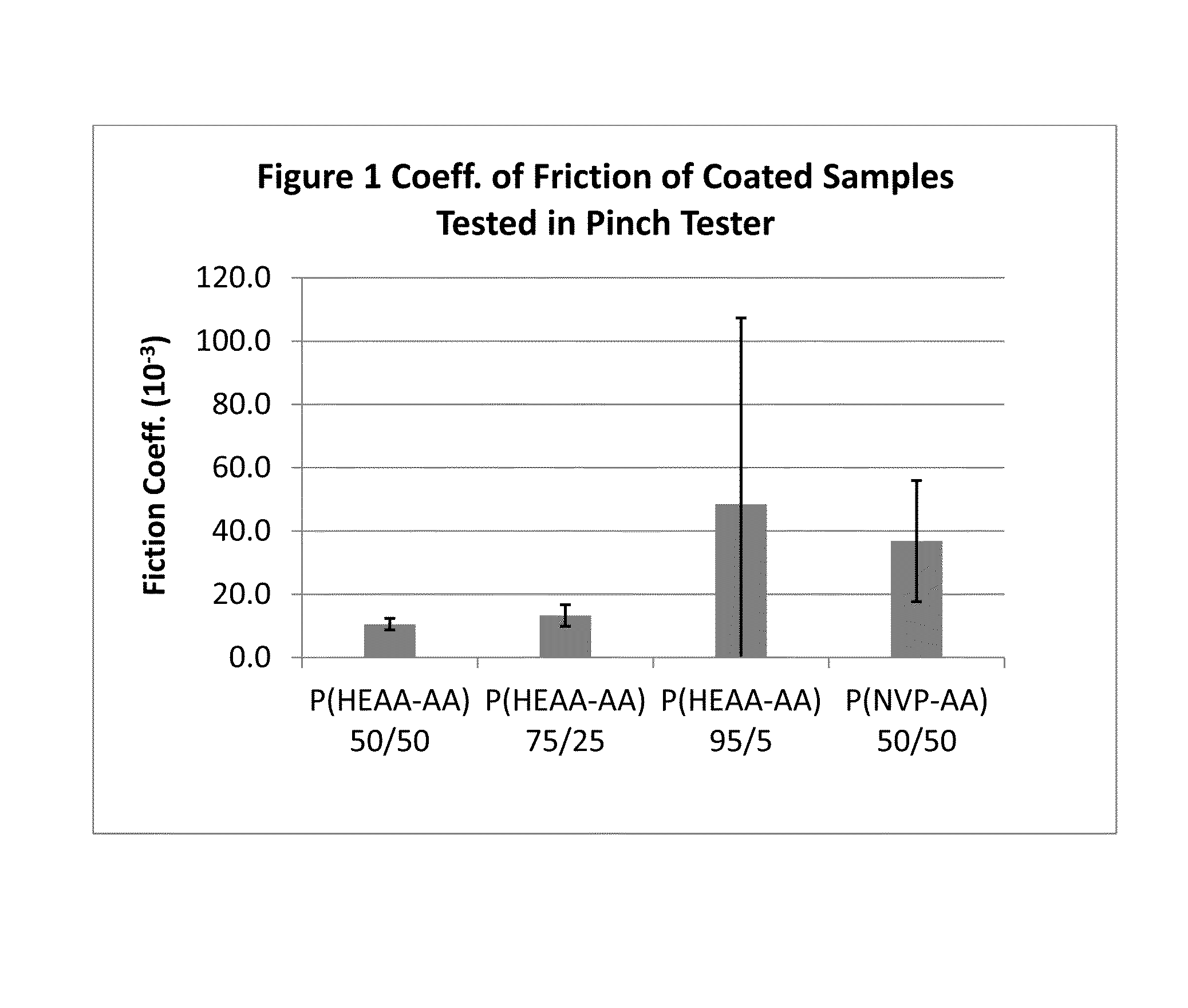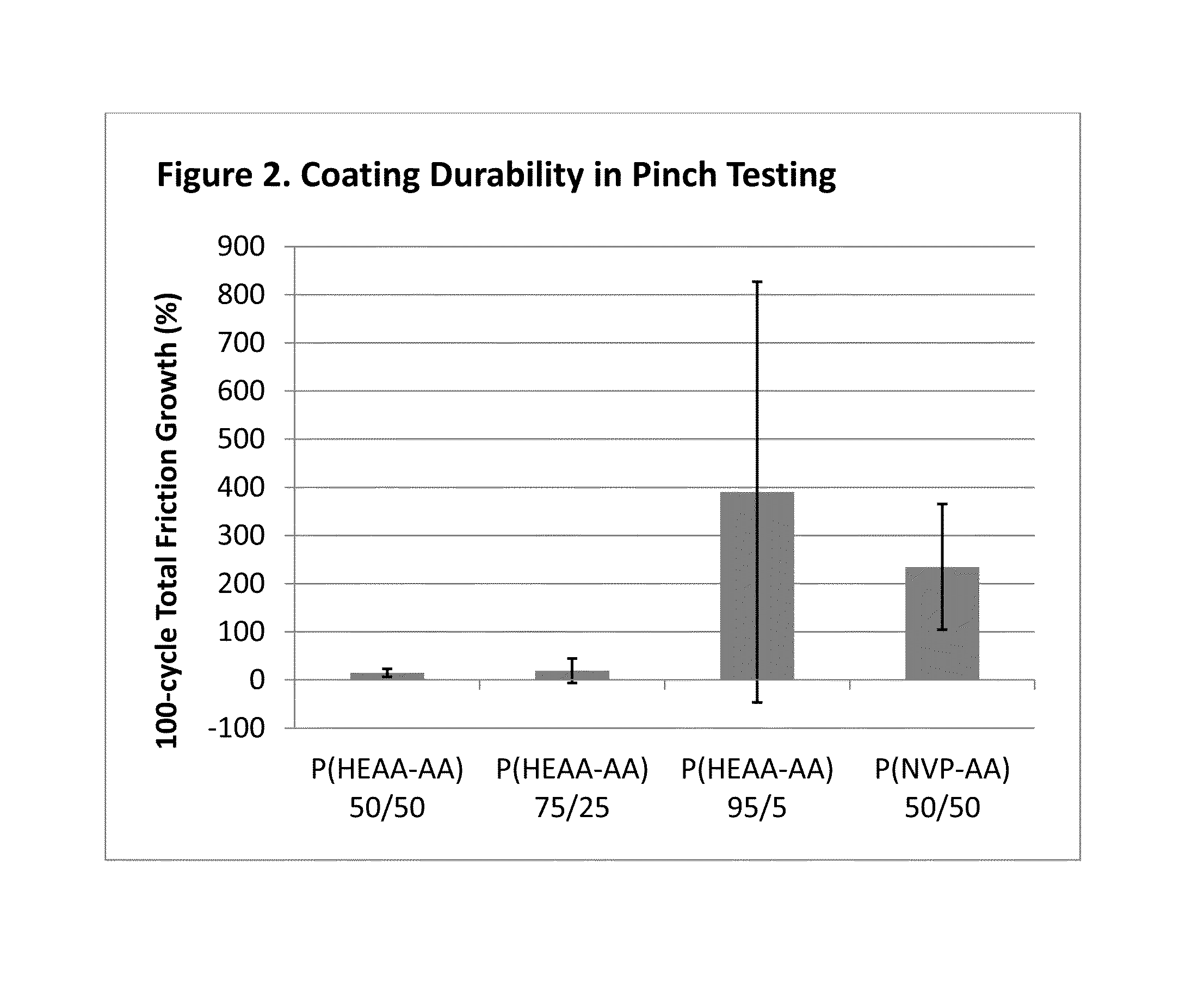Hydrophilic and non-thrombogenic polymer for coating of medical devices
a technology of medical devices and polymers, applied in the direction of antifouling/underwater paints, synthetic resin layered products, drug compositions, etc., can solve the problems of mechanical abrasion and discomfort, metals and plastics have poor lubricity, and lack of resemblance, and achieve the effect of high durability
- Summary
- Abstract
- Description
- Claims
- Application Information
AI Technical Summary
Benefits of technology
Problems solved by technology
Method used
Image
Examples
example 1
[0074]This Example describes the preparation of poly(N-hydroxyethyl acrylamide-co-acrylic acid) 75 / 25 by mol.
[0075]Reagents used in the polymerization process are N-(2-hydroxyethyl)acrylamide (HEAA), acrylic acid (AA), ammonium persulfate (APS), sodium hydroxymethanesulfinate hydrate (SHMS) and ferrous sulfate heptahydrate (FeSO4 7H2O) and high purity water. All the reagents except water are purchased from Sigma-Aldrich. 33.10 g of HEAA and 6.90 g of AA are added into 360 g of high purity water. 0.10 g of APS and 0.065 g of SHMS are used to initiate the polymerization. 0.05 mL of 1% FeSO4 is used as a catalyst. The polymerization is conducted at 40° C. under nitrogen with stirring. The monomer conversion and GPC analysis are conducted for the polymerization products. The results are shown in Table 1. The conversion is measured by drying polymer product solution at 60° C. for 2 hours and then calculated by the equation as follows:
conversion(%)=(weightofsolidsafterdrying)(polymerweigh...
example 2
[0077]This Example relates to the preparation of poly(N-hydroxyethyl acrylamide-co-acrylic acid) 50 / 50 by mol.
[0078]24.00 g of HEAA and 15.01 g of AA are added into 261 g of high purity water. 0.0672 g of APS and 0.0430 g of SHMS are used to initiate the polymerization. The polymerization was conducted at 60° C. under nitrogen with sufficient stirring. The monomer conversion of the polymerization was 104% and the polymer product of 7.80% solids had a viscosity of ‘U’ measured by Gardner bubble viscometer.
example 3
[0079]This Example concerns the preparation of poly(N-hydroxyethyl acrylamide-co-acrylic acid) 95 / 5 by mol.
[0080]37.76 g of HEAA and 1.24 g of AA are added to 261 g of high purity water. 0.0799 g of APS and 0.0520 g of SHMS are used to initiate the polymerization. The polymerization was conducted at 60° C. under nitrogen with sufficient stirring. The monomer conversion of the polymerization was 99.4% and the polymer product of 7.46% solids had a viscosity of ‘G’ measured by Gardner bubble viscometer.
PUM
| Property | Measurement | Unit |
|---|---|---|
| mol % | aaaaa | aaaaa |
| mol % | aaaaa | aaaaa |
| weight average molecular weight | aaaaa | aaaaa |
Abstract
Description
Claims
Application Information
 Login to View More
Login to View More - R&D
- Intellectual Property
- Life Sciences
- Materials
- Tech Scout
- Unparalleled Data Quality
- Higher Quality Content
- 60% Fewer Hallucinations
Browse by: Latest US Patents, China's latest patents, Technical Efficacy Thesaurus, Application Domain, Technology Topic, Popular Technical Reports.
© 2025 PatSnap. All rights reserved.Legal|Privacy policy|Modern Slavery Act Transparency Statement|Sitemap|About US| Contact US: help@patsnap.com



